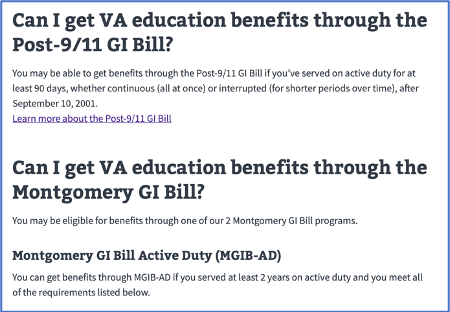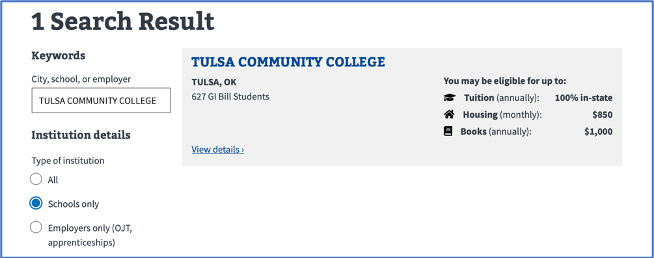This customer experience profile is from 2020. To view this year’s profile, click here.
Executive Summary
The Veterans Benefits Administration provides a wide array of benefits related to education and career training programs. In the past few years, it has been working to streamline these programs, improve its communication with veterans and other stakeholders, and launch campaigns to keep veterans informed about how to access and manage education benefits.
The VBA provides education and disability benefits, pensions and home loans, and getting timely decisions on these benefit claims is important to veterans. In 2019, the agency met its goal of processing education benefit claims in fewer than 28 days. The VA also overhauled its appeals process, reducing the average time it took to review a decision regarding benefits from more than three years to just two to three months.
To improve the experience further, veterans would like more digital, self-service options for receiving and managing education benefits, especially as they look to complete more interactions online during the coronavirus pandemic. Based on feedback from veterans, the VBA is also working on rebranding its education and career counseling program to align better with veterans’ needs.
Data at a Glance

Nearly 2Xs faster: VBA processed education benefit claims nearly 2Xs faster in the first half of 2020 compared to 2018.

The VA greatly reduced its timeline for processing appeals from veterans on benefits decisions.
Service Overview
The VBA supports veterans in multiple ways, including through education and disability benefits, pensions and home loans. And each year, the agency provides education benefits to nearly a million veterans and service members, as well as their families, helping them find the right schools or training programs, pay education expenses and access career counseling.
Primary Customers
Veterans and service members, and their families.
Key education and training services (data for fiscal 2019 unless otherwise stated)
- Information about eligibility for education and training benefits, the application process and status of payments.
- Processing of claims and applications for education and training benefits programs.
- 4 million education benefits claims processed.
- Payment of tuition and fees, monthly housing stipends, books and other related expenses.
- $10 billion in benefits paid.
- Assistance with finding schools where veterans can use their benefits.
- Education and career counseling to support job searches, identify training programs and help veterans meet their training and employment goals.
- Coordination with school officials, so they understand the VBA benefits available and can answer the questions veterans frequently ask.
People Interact With VBA By
(All data for fiscal year 2019)

CALLING THE EDUCATION CONTACT CENTER
2.3 million
calls answered
(2.4 million in fiscal 2018)
Average wait times not provided by VBA

CONTACTING THE NATIONAL CALL CENTER
handles other non-education benefit inquiries
5.4 million
calls answered
(6.2 million in fiscal 2018)

VISITING ONLINE
>300 million
visits to VA.gov
(280.1 million in fiscal 2018)

VISITING A VBA REGIONAL OFFICE
56 locations1
regional offices
Customer Experience Insights
Click tabs to expand
The VBA has improved engagement and communication with veterans about education and job training benefits.
Listening sessions highlighted the desire of veterans and other stakeholders for better and more frequent communication from the VBA, particularly as new legislation changed how education benefits were calculated. Veterans were initially confused about how these changes would affect them, according to Charmain Bogue, executive director of VA Education Service. And a bumpy initial rollout of new IT systems for calculating and delivering housing allowance payments for students resulted in some veterans receiving incorrect amounts.
Using the insight gains through the listening sessions, the VBA launched nationwide email campaigns and other communications efforts, as well as events at schools and on social media, to educate veterans and school officials about applying for and using benefits. These campaigns helped ensure guidance was consistent across the country and enabled schools and veterans service organizations to amplify the VBA’s messages when they talked with veterans.

Customers appreciated that their education benefit claims were processed in a timely manner.
During COVID-19, claims processors and telephone agents were able to seamlessly transition to telework and avoid delays in processing claims, according to Margarita Devlin, the VA’s principal deputy undersecretary for benefits.
- In the first half of 2020, the VBA processed initial education benefits claims in 14.5 days, on average, and supplemental claims in fewer than seven days, on average—nearly half the time it took in 2018.
Average Processing Time for Benefit Claims (2018 and 2020)
| 2018 | 20202 | |
| Initial education benefits claims | 24.5 days | 14.5 days |
| Supplemental claims | 12.3 days | 6.9 days |
Online content that helps veterans learn about education benefits was easy to understand and navigate.
Selected webpages that describe eligibility criteria for receiving VA education benefits and provide tools for understanding what benefits are available received an A- in our analysis.
Click to see full results of our website experience analysis
Website Experience:
How easy is it to navigate and understand online information?
Reviewers looked at the pages from the perspective of people seeking to answer two questions:
- Am I eligible to received education benefits through the VA?
- What specific education benefits are available to me?
VBA Grade
A-
Strengths
- Webpages use clear question headings that address different types of assistance, which users can easily skim to determine if they qualify.
- The text is conversational and easy to read and does not use jargon or difficult words.
- The site uses simple bullet structures such as “all of these must be true” or “one of these must be true” to address complex scenarios.
Opportunities to improve
- The site could use a prominent header at the top of the page that outlines the different types of assistance, so users do not need to scroll through the entire page to see what is available.
Standout Feature
- The GI bill® comparison tool is intuitive and helps veterans easily research colleges and employers approved for the GI bill by asking them a few questions about themselves and the education programs they are considering. At the end, they receive an estimate of their GI bill benefits and which benefits they would receive at different schools.


Veterans would like more digital, self-service options for receiving and managing education benefits.
For example, veterans would like online access to information such as their total amount of approved benefits, what they have spent so far and what funds remain. This information is available online for only some of the agency’s education and training programs.
Veterans also would like to receive communications through additional digital formats, according to Bogue, from the VA Education Service. The VBA is exploring using text messages to inform veterans when they have been approved for a benefit or when payments are sent.
The VBA is redesigning its education and career counseling program to better connect with veterans and meet their needs.
Some veterans who were eligible for career counseling to help guide them through their education and employment plans did not know about the VBA program and how it could help them—an issue uncovered in listening sessions.
In 2019, the VBA began redesigning and rebranding this program to align with the varied needs of veterans. VBA staff members designed more flexible options, ranging from one-off conversations about professional goals to more intensive career support. They also developed a marketing strategy to reach new veterans at schools with previously low participation rates in the program.
Along the way, team members learned that the word “counseling” in the original name gave veterans the impression that the program was for mental health issues, so as part of the rebranding, they renamed the program the Personalized Career Planning and Guidance Program.
Making the Appeals Process Work for Veterans
Sometimes veterans choose to appeal a decision the VA makes about their education, disability, health care or other benefits. By 2015, it was clear to VA leadership that this appeals system was bogged down and needed reform, said David McLenachen, director of the VBA’s Appeals Management Office. It was taking the VA anywhere from three to seven years to make a final decision on an appeal, with some cases taking nearly 20 years. The department also had a backlog of half a million appeals. It was “an excellent example of poor customer service,” McLenachen said.
The VA set out to fix this process with the goal of “giving veterans choice, clarity and control of their appeals and claims,” said Cheryl Mason, chairman of the Board of Veterans’ Appeals. VA leaders knew that to reform a complex process written into law would require a customer-centered approach with input and support from stakeholders, including veterans service organizations, local government officials and congressional staff. In March 2016, the VA gathered representatives from these groups for more than six days of collaborative working sessions to agree on how to fix the appeals process. Engaging these stakeholders built trust and ownership of the redesigned process, which has been critical to its success.
The group helped the VA design a new process, which was signed into law in 2017. The VA fully implemented required changes by February 2019, keeping stakeholders involved in the implementation. While the old appeals process had just one way for veterans to disagree with a decision, the new process gives veterans three different options, allowing them to choose which is best depending on their circumstances.
In the old system, it was hard for veterans to know how long it would take the VA to make a decision because claims remained open until a decision was made. If a veteran added more information at any point, the claim had to be reviewed again, creating delays. In giving veterans three different ways to appeal, the VA provides customers with an estimated timeframe for each option and guidance about when they can add more information to a claim, enabling them to select the best option for their needs and to receive a decision more quickly.
As of April 2020, the VA had reduced years-long processes to an average of 60 days for decisions on higher-level reviews, and 80 days for decisions on supplemental claims. Board of Veterans’ Appeals decisions require a more in-depth review and often take a year or more.
The new process not only is faster, but it also includes a built-in quality feedback loop, which allows the VA to check the accuracy of decisions. The VA can more quickly identify mistakes made when processing claims and provide additional training to staff, a feature that may lead to reduced appeals. The improved process is also more rewarding for employees, who can provide faster responses to veterans.
Connecting on Social Media
The VBA uses social media to highlight services available to veterans, for example, training programs they can access, and support lines for veterans who may be in crisis. Posts provide answers to frequently asked questions and promote online events, during which veterans can ask VBA executives and staff members questions. These events also help the VBA identify common questions and concerns they can address through online guidance and other channels.
As of September 2020, the agency’s social media presence included:
YouTube
(Veterans Benefits Administration)
Joined: July 2014
Subscribers: 17,200
Total views: 2.5 million
Social media practices
Posts almost daily?
Yes
Responds to customers?
No
Includes multimedia content?
Yes
For background information on these metrics and our full methodology click here.
How the VBA shifted education services during the coronavirus
Listening to customers and quickly sharing feedback with employees—from front-line staff members up to agency leaders—was essential as the VBA sought to meet shifting customer needs during the coronavirus. When the pandemic first hit, the staff got calls from veterans receiving education assistance who were concerned that, under the existing rules, the VA would reduce their housing allowances as their classes shifted online—leaving many of them unable to both pay rent and continue their studies. Staff quickly notified VA leaders, who worked with Congress on the issue. Within two weeks, legislation passed that allows the VBA to maintain current levels of housing payments during the crisis.
The VBA also focused on shifting the education services staff to telework in a way that would not impede quality customer service. Because the agency had previously experimented with telework for its call center representatives and claims processors, this transition was easier than it might have been otherwise, according to Margarita Devlin, the VA’s principal deputy undersecretary for benefits. The agency was also able to shift career counseling sessions online using VA Video Connect, software the VA built with telehealth services in mind.
The biggest challenge for shifting services during the crisis was having to deal with the VBA’s reliance on paper-based processes in many cases, according to Devlin. The agency had to scramble to scan hard copies of files on veterans receiving career counseling, and paperwork for education benefits, and manage those files electronically for the first time.

Indicators that the Customer Experience is a High Priority
Click buttons to expand.
Commitment to Customer Experience
The agency:
Includes high-quality customer experience in its strategic goals.
Customer service is listed as a top priority in the VA’s strategic plan and the plan provides specific actions.
Specifies customer feedback as a key measure of the organization’s performance.
Veterans’ trust in the VA is a key performance measure in the strategic plan.
Has a senior executive with the responsibility and authority to lead efforts to improve customer experience across the organization.
VA has a chief veterans experience officer who reports directly to the secretary and whose work spans service delivery channels.
Shares meaningful customer feedback data with the public.
The VA shares detailed customer feedback on health care services with the public and is working to make similar feedback available for education benefits.
Customer Service Basics
For the most common services provided, customers can:
Complete frequently used transactions online.
For Post-9/11 GI Bill benefits veterans can sign into online accounts to apply, view their payment history, request changes to benefits, and change their direct deposit information. However, detailed account information for programs created before the Post-9/11 GI Bill is not available online.
Easily find information to call an appropriate VBA representative.
The VA provides a VA 311 number that is clearly located on the top right corner of its website. There is also a Post-9/11 GI Bill hotline number that is easily found on the education benefits page. When a customer calls the VA311 line, they can get routed to the Post-9/11 GI Bill hotline number using the automated menu.
Schedule in-person appointments.
Most VA regional offices do not offer in-person assistance with education benefits. Instead, several call lines are available for beneficiaries to get information about these benefits. The agency also provides services through programs on college campuses.
Obtain status updates.
Veterans can check the status of payments online if they are Post-9-11 GI Bill recipients, but not for older education programs.
Find standardized and consistent information and guidance across channels.
VBA uses agency-wide governance practices to standardize content on VA.gov, and the content that contact center agents use to answer customers’ questions.
Customer Feedback
The agency collects and analyzes data and information on customer perceptions:
Of specific interactions, including website visits, phone calls and in-person appointments.
Of a customer journey through a series of interactions or multistage processes that build toward a specific goal.
VBA collects information on the customers’ perceptions on applying for, enrolling in and receiving education benefits.
Of the overall service the organization provides.
Through qualitative research, such as customer interviews, focus groups, analysis of social media comments or direct observation.
For example, the VBA does listening sessions with veterans across the country.
Through a structured analysis of comments about the service left on social media channels.
Footnotes
1 VBA’s education services are available in two of the 56 regional offices.
2 Fiscal 2020 data reflects data as of August 6, 2020.
Social media review methodology
To assess how agencies use social media to interact with customers, we examined three social media best practices identified through conversations with experts: posting frequently, delivering engaging content and responding to questions. We analyzed the most active Facebook or Twitter account by selecting specific months to examine trends throughout the year, including changes to social media activity during the coronavirus.
The team defined posting almost daily as meaning the agency posted for at least 25 out of 30 days on average in September 2019, December 2019, March 2020 and May 2020. Includes multimedia content is defined as whether the agency posted a range of multimedia content with interactive elements beyond just static images. Responds to customers is defined as whether or not agencies respond to questions through the direct message feature on Facebook or in the comment section of posts. To assess this, we examined September 2019, December 2019 and April 2020 (or another month when data was not available). “No” indicates the agency never or rarely responds to comments; “Yes – occasionally” indicates the agency responds sometimes, but there does not appear to be a consistent pattern over time; and “Yes – regularly” indicates the agency responds to comments on a frequent and consistent basis over time.
The number of tweets, likes, posts and views reflect the total activity since the social media account was established.
Website experience methodology
For each agency, we selected for review a set of webpages that customers would theoretically visit to seek answers to frequently asked questions, vetted with each agency.
We partnered with the Center for Plain Language to conduct this review. The center followed the same methodology it uses to assess plain language for its annual ClearMark awards for a range of organizations and its annual Federal Plain Language Report Card for the government. Two plain-language experts individually and independently reviewed and scored each set of pages, using five plain-language criteria to assess each site. They rated each criterion on a five-point scale:
- Information design and navigation.
- Pictures, graphics and charts.
- Style or voice.
- Structure and content.
- Understanding of audience.
The reviewers then met to reach consensus on strengths and weaknesses of each site and to assign a letter grade based on their ratings.
Customer experience indicators methodology
The Partnership and Accenture developed the following list of indicators to understand how agencies prioritize the customer experience, and steps they can take to improve. The list is based on research about effective customer experience practices in both government and the private sector, and aligns with practices in a customer experience maturity self-assessment for agencies developed by the Office of Management and Budget. Leaders who participated in the Partnership’s federal customer experience roundtable provided input.
Commitment to customer experience
The agency:
- Includes high-quality customer experience in its strategic goals.
Criteria: 1) customer experience with the agency’s services is listed in the strategic plan as one of the organization’s top priorities or a supporting goal of one of the priorities 2) the strategic plan provides specific actions the agency will take to improve customer experience. - Specifies customer feedback as a key measure of the organization’s performance.
Criteria: There is a performance measure included in the agency’s strategic plan, annual performance report or agency priority goals that is based on feedback directly from customers - Has a senior executive with the responsibility and authority to lead efforts to improve customer experience across the organization.
Criteria: Based on a review of the agency organizational chart and online descriptions of leadership positions, the agency has an executive who meets the following criteria: 1) customer experience is his or her primary responsibility 2) he or she reports to the head of the organization or a deputy 3) his or her work spans all major service delivery channels (e.g., online services, contact centers, face-to-face services). - Shares meaningful customer feedback with the public.
Criteria: In alignment with the Office of Management and Budget’s guidance on customer experience measurement, the agency publishes customer feedback that: 1) represents multiple service delivery channels 2) provides details into different aspects of the experience (e.g., beyond overall customer satisfaction)
Customer Service Basics
For the most common services provided, customers can:
- Complete online frequently used transactions.
Criteria: Based on a review of the agency’s website, customers can complete major services or transactions online. - Easily find information to call an appropriate representative.
Criteria: Does the agency’s website provide a clear explanation of which number to call for specific issues or provide one number that customers can call to get routed to the appropriate person. - Schedule in-person appointments.
Criteria: Based on a review of the agency’s website, customers can schedule appointments for in-person services. - Obtain status updates.
Criteria: Customers can get current updates through an online or self-service channel that includes estimated timelines on items such as submitted applications or benefit disbursements. - Find standardized and consistent information and guidance across channels.
Criteria: At least two service delivery channels have integrated knowledge management systems so that when content for customers on one channel is updated, it is updated on the other channel.
Customer Feedback
The agency collects and analyzes data and information on customer perceptions:
- Of specific interactions, including website visits, phone calls, and in-person appointments.
- Of the customer journey through a series of interactions or multi-stage processes that build toward a specific goal.
- Of the service provided by the organization overall.
- Through qualitative research, such as customer interviews, focus groups or direct observation.
- Through a structured analysis of comments about the service left on social media channels.

This customer experience profile was produced in collaboration with Accenture Federal Services.